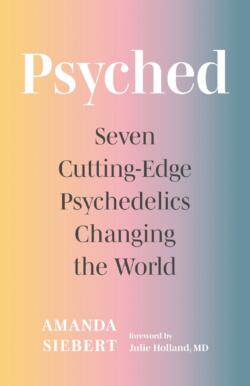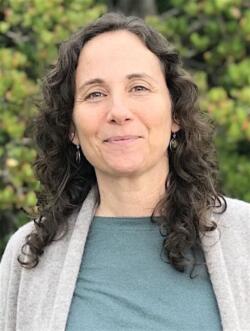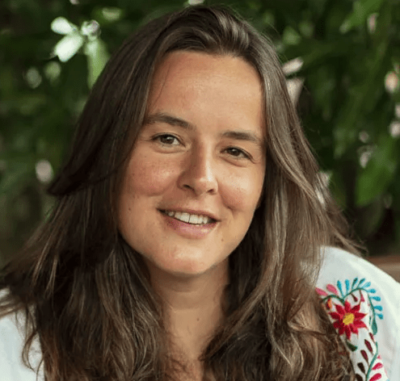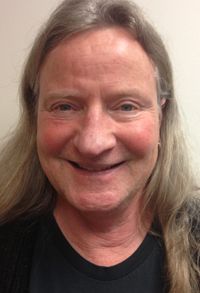1636 Siebert’s seven psychedelics
Psyched: Seven Cutting-Edge Psychedelics Changing the World
by Amanda Siebert, with a foreword by Julie Holland
Vancouver: Greystone Books, 2022
$21.95 / 9781771648790
Reviewed by Colin James Sanders
*
 While the title of Amanda Siebert’s latest book may be overreaching in its claim that psychedelics are changing the world, psychedelic-assisted therapeutic practices are definitely experiencing an important renaissance. Siebert, of New Westminster, author of The Little Book of Cannabis: How Marijuana Can Improve your Life (Greystone Books, 2018) in Psyched: Seven Cutting-Edge Psychedelics Changing the World, has written a balanced contribution to the burgeoning literature dedicated to the revival of interest in the therapeutic application of psychedelics.
While the title of Amanda Siebert’s latest book may be overreaching in its claim that psychedelics are changing the world, psychedelic-assisted therapeutic practices are definitely experiencing an important renaissance. Siebert, of New Westminster, author of The Little Book of Cannabis: How Marijuana Can Improve your Life (Greystone Books, 2018) in Psyched: Seven Cutting-Edge Psychedelics Changing the World, has written a balanced contribution to the burgeoning literature dedicated to the revival of interest in the therapeutic application of psychedelics.
Siebert’s book begins with the personal narrative of her experiences with the therapeutic use of psychedelics. Sharing that “…when I was diagnosed with PTSD (post-traumatic stress disorder), depression, and anxiety after coming to terms with sexual trauma I experienced in my early twenties” (p. 3) and compounded by the demise of a personal relationship, Siebert, following consultation with her doctor, commenced microdosing with psilocybin. Siebert’s experiences with psilocybin, followed by ayahuasca, were positive ones. Psychedelics were thus an integral part of the healing, transformational, process for Siebert, in conjunction with “therapy, a healthy diet, regular exercise, and a regimented schedule prioritizing rest and self-care….” She writes that having positive “experiences with psychedelics like psilocybin and ayahuasca helped me overcome debilitating diagnoses (along with a debilitating sense of worthlessness)” (pp. 4-5).

Where therapeutic practices are concerned, options to pharmaceutical drugs should exist to assist persons struggling with psychosocial dilemmas and imbalances within the context of their lives and relationships. Alternatives to pharmaceutical drugs, such as the use of psychedelics, should be available as one such option.
Throughout her book, Siebert cautiously and conscientiously observes that psychedelics are not for everyone, and that ethical and accountable processes regarding assessment and preparation are necessary requirements for anyone pursuing such a course of treatment. Certainly, there are some dilemmas for which psychedelic alternatives would not be appropriate, and, in fact, could adversely impact a person’s psyche and well being. Psychedelics would be contraindicated for persons struggling with schizophrenia and psychoses, whereas neuroleptic, anti-psychotic, drugs could provide some solace in managing such conditions.
There exists a significant literature critiquing the over-prescribing of pharmaceutical drugs, and related concerns regarding developing long-term dependency on such drugs (cf. Breggin, 1991; Whitaker, 2002). Recently, The New York Times published a front page article about a high school student prescribed ten different psychiatric drugs, noting that “Increasingly, anxious and depressed teens are using multiple, powerful psychiatric drugs, many of them untested in adolescents or for use in tandem” (Richtel, 2022).

I remain curious as to whether the resurgence of interest in the therapeutic use of psychedelics may be troubling for BigPharma. Currently, North America has witnessed an exponential increase in the use of psychotropic medications/drugs in the treatment or management of depression, obsessive-compulsive behaviours, anxiety and other dilemmas.
In North America pharmaceutical companies reap immense profits annually. McGlauflin (2022) notes that “The world’s 10 biggest pharmaceutical companies raked in over $700 billion in revenue in 2021,” while “There are over 78 million people taking psychiatric drugs in the United States with global sales reaching $76 billion a year” (EIN Newsdesk, May 26, 2021). Pharmaceutical companies spend liberally and intentionally in financially supporting psychiatrists, thus influencing prescribing practices. Robert Whitaker (2021) notes, “From 2014 to 2020, pharmaceutic companies paid $340 million to U.S. psychiatrists to serve as their consultants, advisers, and speakers, or to provide free food, beverages and lodging to those attending promotional events.”
Unlike most medically prescribed pharmaceutical drugs, the therapeutic use of psychedelics is intended to be short term, while use of psychiatric medication to manage phenomenon such as anxiety, depression, bi-polar, anorexia/bulimia, et al., can lead to long term dependency, and in many instances contribute to a plethora of negative or debilitating side effects.

Siebert interviews James Fadiman, known for his research on the microdosing of psychedelics. Regarding psychological affect, “Fadiman makes the important distinction namely that unlike antidepressants, which decrease depression but also suppress emotions in general, microdosing allows people to experience improvements not only in normal depression measurements, but also in positive moods” (pp. 61-62). Of course, once again, the use of psychedelic drugs may not be for everyone, as Siebert notes. “Fadiman says that, as with any treatment, not all people who try microdosing find it helpful, and in examining the reports he’s received, he’s noted that people who struggle with anxiety sometimes describe feeling increased anxiety, or becoming more aware of it” (p. 62).
That said, for treatment-resistant persons, having options, having choices, remains of primary importance. As of January, 2022, BC doctors can apply to Health Canada for access to psychedelics such as MDMA and psilocybin for terminally ill patients and persons who are otherwise treatment-resistant.
Siebert provides an important historical context regarding Indigenous sacred practice and cultural traditions associated with the use of psychedelics as healing medicines. Accounting for this historical context lends credibility for the use of psychedelics within a context of healing. Marking the distinction between recreational use of psychedelics and their utilization as therapeutic alternatives to pharmaceutical drugs is a crucial consideration.

Siebert quotes from an interview with Bia Caiuby Labate, “…a queer Brazilian anthropologist and the founder of the Chacruna Institute [of Psychedelic Plant Medicines in San Francisco], an organization that aims to educate the public about psychedelic plant medicines like ayahuasca while presenting academic knowledge on their cultural uses in a more accessible way…” (pp. 89-90). And, Siebert continues, “Anybody and everybody in the psychedelic movement has some kind of debt to Indigenous people. We are all heirs of this tradition and this knowledge … there is a continuity between the shamanic uses, the underground therapeutic uses, and the above-ground clinical trials” (p. 91).
Siebert also observes that the archaeological record attests to the ancient use of psychedelics within Indigenous cultures:
Throughout Mexico and Central America, mushroom statues were erected between 100 and 1400 CE, and some in a region of Guatemala possibly date even earlier, from around 500 BCE. Spiritually revered, these mushrooms were referred to as teonanacatl, a word in the Nahuatl language used by the Maya, Aztec, and Toltec civilizations meaning “god mushroom” or “flesh of the gods” (p. 26).

Closer to home, Siebert makes note of the fact that between the 1950s to mid-1975, “…some of the most important psychedelic and psychology research was taking place in Canada” (p. 12). Innovative treatment and research using LSD-25 occurred at the Weyburn Mental Hospital, Saskatchewan (Dyck, 2012) and also in New Westminster, at the Hollywood Hospital (Donaldson and Dyck, 2022), close to where Siebert lives today. Siebert notes that the psychiatrist Humphry Osmond, conducting LSD treatment and research at the hospital in Weyburn, Saskatchewan, created the word “psychedelic” (p. 9).
Siebert synthesizes a significant amount of psychedelic clinical research from reputable journals in Psyched: Seven Cutting-Edge Psychedelics Changing the World. The book is well organized in its descriptions of seven psychedelics, and each chapter is prefaced with an experiential “case study” narrative. The author also discusses drug administration, describes how each psychedelic works, and provides information relating to appropriate therapeutic dosing; finally, each chapter contains a section relating to “early use” and cultural history of each drug.
Siebert’s well-written brief history of the use of psychedelics within therapeutic contexts is recommended as an introduction and portal into future readings on the potential for healing associated with psychedelic assisted therapeutic practices.
*

Colin James Sanders, PhD, husband, father, grandfather, lives with his partner Gail and their creature companions on the unceded traditional lands and waters of the Skwxwú7mesh Úxwumixw and the shíshálh Nation on BC’s Sunshine Coast. Amongst his professional accomplishments, Colin co-created a live-in program for young persons struggling with substance use and was a professor from 1998-2018, and a Director of the Master of Counselling Programs, at City University of Seattle’s Vancouver campus. Colin has presented his work throughout Canada and in San Francisco and Havana. Colin has published academic book chapters and journal articles relating to his therapeutic practice over the decades, in addition to book reviews, interviews, and essays on poetry and poetics. Colin is a member of the Editorial Board of The GTEC Reader, an online journal of Vancouver’s Green Technology Education Centre. Recent publications include a two-part essay on the climate crisis and eco-socialism; a poem illustrated by several of his paintings and a memoir recalling his therapeutic praxis in New Zealand’s online Journal of Contemporary Narrative Therapy. Colin spends his time learning from his grandchildren, reading, writing, painting, and travelling. Editor’s note: Colin Sanders has also reviewed a book by Keith Warrior for The British Columbia Review.
*
REFERENCES:

Breggin, P. R. (1991). Toxic Psychiatry. New York, NY: St. Martin’s Press.
Dyck, E. Psychedelic Psychiatry: LSD on the Canadian Prairies (University of Manitoba Press, 2012)
EINNews. (May 26, 2021). Mental Health Month Marketing Fuels Billion Dollar Psychiatric Drug Industry
McGlauflin, P. (2022). The World’s 10 biggest pharmaceutical companies raked in over $700 billion in revenue in 2021. Fortune. August 15, 2022.
Richtel, M. (2022). This Teen was Prescribed 10 Psychiatric Drugs. She’s Not Alone. The New York Times, 27 August 2022.
Whitaker, R. (2002). Mad in America: Bad science, bad medicine, and the enduring mistreatment of the mentally ill. Cambridge, MA: Perseus.
Whitaker, R. Anatomy of an Industry: Commerce, Payments to Psychiatrists and Betrayal of the Public Good. Mad in America, September 18 2021
Donaldson, J. and Dyck, E. (2022). The Acid Room: The Psychedelic Trials and Tribulations of Hollywood Hospital. Vancouver: Anvil Press (reviewed by Ron Verzuh).
*
The British Columbia Review
Publisher and Editor: Richard Mackie
Formerly The Ormsby Review, The British Columbia Review is an on-line book review and journal service for BC writers and readers. The Advisory Board consists of Jean Barman, Wade Davis, Robin Fisher, Barry Gough, Hugh Johnston, Kathy Mezei, Patricia Roy, Maria Tippett, and Graeme Wynn. Provincial Government Patron (since September 2018): Creative BC. Honorary Patron: Yosef Wosk. Scholarly Patron: SFU Graduate Liberal Studies.
“Only connect.” – E.M. Forster
One comment on “1636 Siebert’s seven psychedelics”